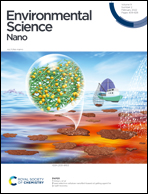Multi-omics analysis reveals size-dependent toxicity and vascular endothelial cell injury induced by microplastic exposure in vivo and in vitro†
Abstract
Although microplastic (MP) pollution has recently garnered increasing attention, few studies have examined the effects of these small particles on the vascular system. Therefore, the aim of the current study was to precisely identify the toxicity of MPs toward endothelial cell (EC) function, in vivo and in vitro, and microstructure. Various approaches, including electron microscopy, biochemical analysis, transcriptomics, and metabolomics were applied. Human umbilical vein ECs were treated with different sizes of MPs; cell viability, migration, and apoptosis were evaluated using CCK8, transwell, and Annexin V/propidium iodide analyses. Mitochondrial function was further assessed through reactive oxygen species (ROS) and JC-1 staining. The transcriptomic and metabolomic responses to MPs were revealed based on RNA sequencing and liquid chromatography-mass spectrometry. In vivo, MPs were found to induce development of serious atherosclerotic plaques, and are closely associated with cardiovascular inflammation responses in vivo. In vitro, smaller MPs were observed to cause more serious EC injury, including reduced cell viability, movement, and tubule formation, and increased apoptosis and ROS generation. Moreover, 720 differentially expressed genes (DEGs) were identified in the 20 nm MP group and 688 DEGs in the 10 μm MP group compared with untreated cells. A further 554 DEGs were detected between the 20 nm MP and 10 μm MP groups. Additionally, 66 differential metabolites were described for the 20 nm MP group, and 89 in the 10 μm MP group, compared with untreated cells, as well as 59 differential metabolites between the 20 nm MP and 10 μm MP groups. Transcriptomics and metabolite analyses identified the hub genes (SEMA3C, EGR1, STAT4, and COLIA2) with abnormal expression in MP-treated ECs and differential metabolite pathways (abnormal alanine, aspartate, glutamate, and sphingolipid metabolism) that may be correlated with the observed cell injury. Finally, multi-omics analysis provided insights regarding the biological relationships between the identified hub genes and metabolites in MP-treated ECs. Overall, these findings suggest that MPs induce an abnormal transcriptomic and metabolomic response in ECs both in vitro and in vivo, which may be applied for the development of effective preventive strategies against MP damage.



 Please wait while we load your content...
Please wait while we load your content...